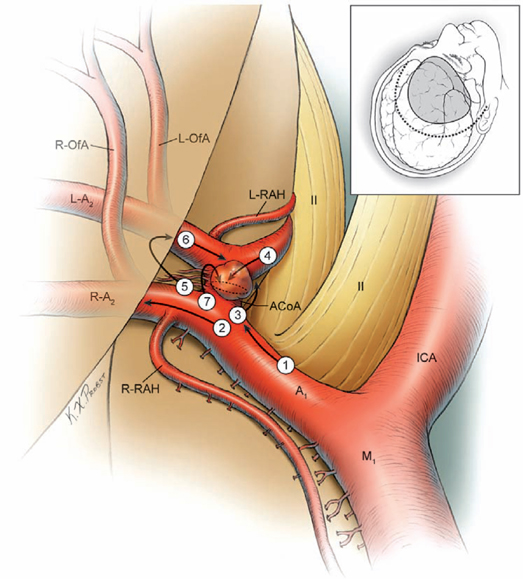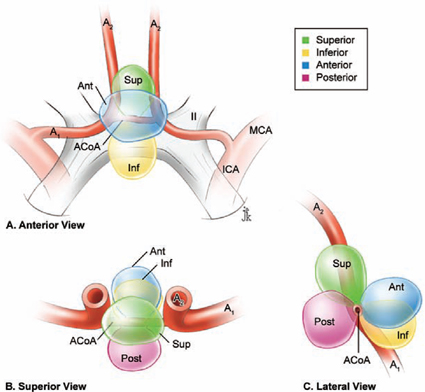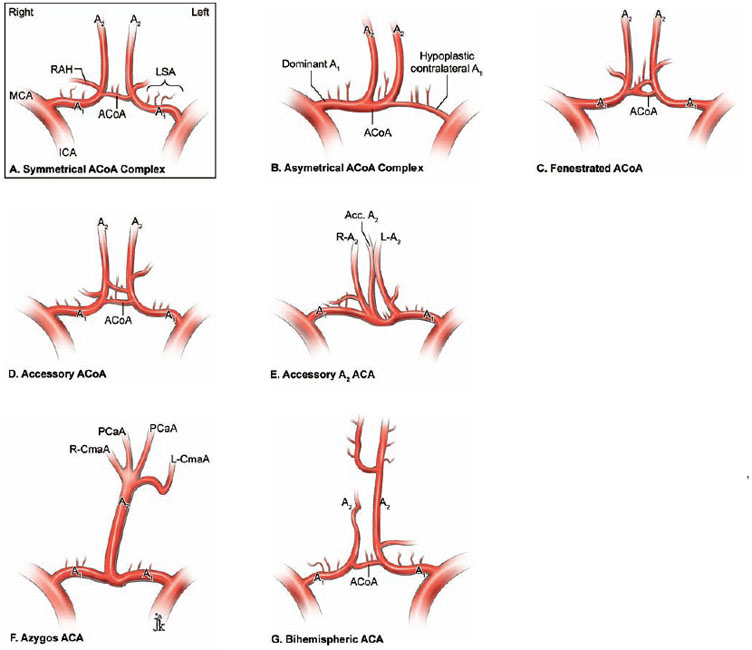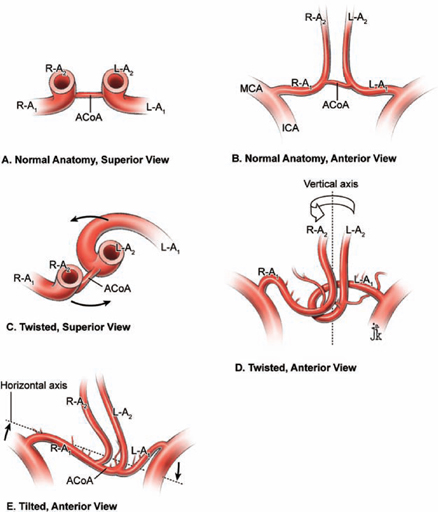16 Anterior Communicating Artery Aneurysms The A1 segment begins at the terminal bifurcation of the internal carotid artery (ICA) and ends at the anterior communicating artery (ACoA) (Fig. 16.1). This precommunicating segment is also called the horizontal segment because of its flat course across the optic tract to the midline. Even though the A1 segment begins and ends at branch points, the segmental anatomy of the anterior cerebral artery (ACA) is defined by its curvature and its relationships to the brain rather than by branch anatomy. The A2 segment, or post-communicating segment, begins at the ACoA and follows the rostrum of the corpus callosum. The A3 segment, or precallosal segment, curves around the anterior corpus callosum, following the genu until the artery assumes a posterior course. The A4 (supracallosal) and A5 (postcallosal) segments continue over the anterior and posterior halves, respectively, of the body of the corpus callosum, with the vertical plane of the coronal suture dividing them. The ACA’s bifurcation into the pericallosal artery (PcaA) and the callosomarginal artery (CmaA) does not define these distal segments. Anterior communicating artery aneurysm dissection identifies 12 arteries: ipsi- and contralateral A1 segments; ipsi- and contralateral A2 segments; the ACoA; ipsi- and contralateral recurrent arteries of Heubner; ipsi- and contralateral orbitofrontal arteries; ipsi- and contralateral frontopolar arteries; and the collection of ACoA perforators. The ipsilateral A1 segment is identified at the ICA terminus and leads medially and anteriorly over the optic tract and chiasm to the ACoA. On average, eight medial lenticulostriate arteries originate from the superior surface of the A1 segment and ascend to the anterior perforated substance, subfrontal area, hypothalamus, anterior commissure, septum pellucidum, and paraolfactory structures. A1 segments are symmetric in most people (90%), but can be asymmetric due to hypoplastic or aplastic A1 segments. Despite the suggestion by angiography, absence or true aplasia of the A1 segment is rare and a vestige can be found intraoperatively. A1 segment dominance is relevant to aneurysm formation, dome projection, side of hematoma, side of surgical approach, and proximal control. Duplicated A1 segments are rare (2% of patients). A recurrent artery of Heubner is considered the “medialmost” medial lenticulostriate artery, defining the inner border of the collection of perforators along the A1 segment (medial lenticulostriates) and M1 segment (lateral lenticulostriates). As its name implies, a recurrent artery of Heubner travels back along the A1 segment to supply the head of the caudate nucleus, the putamen, the outer segment of the globus pallidus, and the anterior limb of the internal capsule, and its injury can produce contralateral face and arm weakness and expressive aphasia in the dominant hemisphere. A recurrent artery of Heubner originates on the lateral wall of the proximal A2 segment just distal to the ACoA, almost as lateral continuations of the ACoA. Anatomic variation can shift its origin proximal to the ACoA on the distal A1 segment, or in line with the ACoA at the A1–A2 junction, but a recurrent artery of Heubner lies within 4 mm of the ACoA in 95% of patients. Exploiting this relationship in reverse, a recurrent artery of Heubner is a reliable guide to the ACoA and is particularly useful when A1 segment arcs superiorly out of view. It drapes over the shoulder of the A1 segment at its origin and lies superior (60%) or anterior (40%) to the A1 segment as it recurs laterally. Therefore, a recurrent artery of Heubner is often seen before the A1 segment when the frontal lobe is retracted. The artery can be duplicated in 2% of patients. The ACoA joins the A1 segments as they arrive in the interhemispheric fissure and completes the anterior circle of Willis. ACoA diameter is about half that of the A1 segments, but asymmetric A1 segments increase the ACoA diameter. For example, large-caliber ACoAs are observed with a hypoplastic or absent A1 segment because they cross-fill the nondominant side. The ACoA is always present, and can be duplicated (one third of patients), triplicated (one tenth of patients), fenestrated, or supplemented with an accessory ACoA (Fig. 16.2). Important perforating arteries originate from the ACoA’s superior and posterior surfaces and ascend to the hypothalamus, median paraolfactory nuclei, genu of corpus callosum, columns of the fornix, septum pellucidum, and anterior perforated substance. Perforators also originate from the anterior and inferior aspects of the ACoA and descend to the dorsal optic chiasm. These perforators prevent trapping or dividing the ACoA. If the anterior circle of Willis requires interruption, it is safer to divide the A1 segment, as long as the opposite A1 segment and ACoA are sufficiently large. Fig. 16.1 Microsurgical anatomy of the anterior cerebral artery (ACA). Anterior (A) and oblique (B) lateral views, showing the five ACA segments and 12 arteries that can enter the surgical field around an anterior communicating artery (ACoA) aneurysm. The five ACA segments are asa follows: A1, precommunicating or horizontal segment; A2, postcommunicating or infracallosal segment; A3, precallosal segment; A4, supracallosal segment; and A5, postcallosal segment. CmaA, callosomarginal artery; FpA, frontopolar artery; ICA, internal carotid artery; LSA, lenticulostriate artery; MCA, middle cerebral artery; OfA, orbitofrontal artery; PcaA, pericallosal artery; RAH, recurrent artery of Heubner. Orbitofrontal and frontopolar arteries lie beyond a recurrent artery of Heubner. The orbitofrontal artery is the first cortical ACA branch, arising from the anterolateral surface of the A2 segment approximately 5 mm distal to the ACoA and coursing perpendicularly over the gyrus rectus and olfactory tract. Its course can be similar to that of a recurrent artery of Heubner, but distally it drifts away from the A1 segment, whereas a recurrent artery parallels the A1 segment. Orbitofrontal artery is larger in caliber than the recurrent artery (2 to 3 mm versus 1 mm). The orbitofrontal artery supplies the gyrus rectus, orbital gyri (anterior, posterior, medial, and lateral), and olfactory bulb and tract. The frontopolar artery is the second cortical ACA branch, originating from the A2 segment approximately 14 mm from the ACoA. Rarely, it originates from a common trunk with the orbitofrontal artery. The frontopolar artery courses anteriorly in the interhemispheric fissure and supplies the ventromedial frontal lobes. Fig. 16.2 Normal variations of anterior cerebral artery anatomy. (A) Symmetrical ACoA complex. (B) Asymmetrical ACoA complex with a dominant right A1 segment and a hypoplastic left A1 segment. (C) Fenestrated ACoA, with the fenestration on the left side of the ACoA. (D) Accessory ACoA. (E) Accessory (Acc.) A2 ACA, with a total of three A2 segments originating from the ACoA complex. (F) Azygos ACA. (G) Bihemispheric left A2 segment that sends distal branches to both hemispheres distally. Three variations in efferent A2 segments can lead to misinterpretations of aneurysm anatomy: azygos, bihemispheric, and accessory ACA (Fig. 16.2). The azygos or “unpaired” ACA is a single midline artery arising from the confluence of the A1 segments, and occurs in less than 2% of patients. Distally, the azygos ACA divides into the PcaA and CmaA with bifurcations, trifurcations, or quadrifurcations. The “bihemispheric” ACA is an A2 segment that transmits branches across the midline to both hemispheres, usually in the presence of a contralateral A2 segment that is either hypoplastic or terminates early in its course toward the genu. This anomaly is seen in as many as 12% of patients. The accessory A2 segment is a third artery originating from the ACoA in addition to ipsi- and contralateral A2 segments. The accessory ACA varies in caliber from a small remnant of the median artery of the corpus callosum (MACC), to a hyperplastic trunk resembling an azygos ACA between two smaller A2 segments. The MACC originates during embryogenesis (44 days) when elongating ACAs coalesce in the midline to form plexiform anastomoses. The MACC regresses and disappears as A2 segments mature, but remnants account for the accessory ACA. Anterior communicating artery aneurysms can be approached from either side. The right side is chosen in patients with symmetric A1 segments, and the side of the dominant A1 segment is chosen in patients with asymmetric A1 segments. This policy avoids the speech-dominant hemisphere in patients with balanced anatomy and exploits advantages of A1 dominance: early proximal control, dome avoidance, and favorable view of the neck. Although infrequent in the general population (around 10%), A1 dominance is frequent in the aneurysm population (as high as 80%). Consequently, the side of approach was even divided in the author’s ACoA aneurysm experience. With this policy, intraparenchymal hematomas associated with rupture are typically in the contralateral frontal lobe, but are contiguous with the aneurysm dome and easily evacuated after clipping. The side of approach may be influenced by the presence of other lateral aneurysms that might be treated simultaneously. A standard pterional craniotomy is sufficient for most ACoA aneurysms, but the orbitozygomatic approach increases exposure for large, giant, and complex aneurysms (16% in the author’s experience). The dissection of ACoA aneurysms proceeds in steps that identify the five major arteries of the dozen arteries around the ACoA complex, beginning with the ipsilateral A1 segment (Fig. 16.3, step 1), moving to the ipsilateral A2 segment (Fig. 16.3, step 2), and crossing the midline to the contralateral anatomy via the ACoA (Fig. 16.3, step 3). Proximal control of the aneurysm is completed by identifying the opposite A1 segment (Fig. 16.3, step 4). The contralateral A2 segment is located by entering the interhemispheric fissure above the aneurysm and distal to the dome (Fig. 16.3, step 5). The contralateral A2 segment runs parallel to the ipsilateral A2 segment and perpendicular to the contralateral orbitofrontal artery, which can often be seen anteriorly in the interhemispheric fissure. The contralateral A2 segment is traced proximally to the aneurysm neck (Fig. 16.3, step 6), and finally the ACoA perforators are dissected from the posterior neck and the aneurysm is prepared for the clip blade (Fig. 16.3, step 7). Fig. 16.3 ACoA aneurysm dissection steps. Step 1, following the A1 segment and recurrent artery of Heubner; step 2, identifying the A2 segment; step 3, crossing the midline via the ACoA; step 4, controlling the contralateral A1 segment; step 5, entering the distal interhemispheric fissure; step 6, tracing the contralateral A2 segment proximally; and step 7, separating the perforators from the aneurysm neck. Fig. 16.4 The ACoA complex is rotated in some patients, shifting the relationships between its major arteries. Normal orthogonal anatomy is shown in superior (A) and anterior (B) views. An ACoA complex twisted counterclockwise about its vertical axis brings the right A1 and A2 segments forward into view from a right-sided pterional approach, but the left A1 and A2 segments move backward out of view, as seen in superior (C) and anterior (D) views. (E) An ACoA complex tilted to the left, as shown in this anterior view, brings the left A1 and A2 segments into the view of a right pterional approach, but pulls the right A1 and A2 segments up out of view. Opening the carotid cistern and the proximal sylvian cistern often exposes the distal ICA and the origin of the A1 segment, but a more extensive sylvian fissure split might be needed if the ICA bifurcation is high-riding or if the frontal and temporal lobes cover the ICA bifurcation. Frontal lobe retraction, with the retractor tip on the posterior portion of the medial orbital gyrus, lateral to the olfactory tract, increases visualization of the A1 segment. Retraction with an inferiorly projecting ACoA aneurysm is done lightly and with caution, because it can avulse a dome that adheres to the optic chiasm. A recurrent artery of Heubner is often seen before the A1 segment, and it is mobilized off of the optic tract and chiasm inferiorly and off of the frontal lobe superiorly. Liberating this artery circumferentially positions it prominently in the field as a landmark to the ACoA, and keeps it from being swept under the retractor blade. The inferior surface of the A1 segment is followed medially to avoid perforators on its superior surface, and frontal retraction is shifted progressively from the posterior medial orbital gyrus to the gyrus rectus. The optic apparatus is another orienting landmark that can be followed from the ipsilateral optic nerve, across the anterior edge of the chiasm, to the opposite optic nerve and interoptic triangle, remaining beneath most aneurysms except those projecting inferiorly. After exposing the ipsilateral A1 segment and gaining partial control of the aneurysm, the ipsilateral A2 segment is found by opening the interhemispheric fissure inferiorly where the right and left gyri rectus meet. Brain atrophy, prominent orbitofrontal arteries, or an interhemispheric hematoma facilitate opening this fissure. The ipsilateral gyrus rectus is then lifted with the retractor to view the ipsilateral A2 segment. A high-riding ACoA complex, swollen brain, or tight fissure may call for gyrus rectus resection and entrance into the interhemispheric fissure through the pia of the medial hemisphere, but subarachnoid dissection in the interhemispheric fissure is preferred over brain transgression. The ACoA complex’s classic position has no lateral rotation, with the ACoA and both A2 segments lying in a coronal plane (Fig. 16.4A,B); extreme rotation of the complex orients the ACoA and its A2 segments in a sagittal plane (Fig. 16.4C,D). This twisting of the ACoA complex about a vertical axis shifts the A2 segments and can confuse the dissection. Dominant A1 segments tend to twist the ACoA complex to face the contralateral side in the direction of blood flow (according to Rhoton’s third rule), bringing the ipsilateral A2 segment forward and making it easier to identify. However, an ACoA complex that is twisted toward the side of the approach recesses the ipsilateral A2 segment backward in the fissure and makes it harder to identify. In addition to this twisting rotation, the horizontal axis of the ACoA complex can also tilt (Fig. 16.4E). An ACoA complex tilted downwards on the side of approach lowers the ipsilateral A2 segment and brings it into view low in the interhemispheric fissure; an ACoA complex tilted upwards on the side of approach raises the ipsilateral A2 segment and often requires gyrus rectus resection. Tilting and twisting of the ACoA complex also affects the A1 segment. Tilt toward the opposite side elevates the ipsilateral A1 segment and the superiorly arcing trajectory makes the artery more difficult to visualize.
 Microsurgical Anatomy
Microsurgical Anatomy

 Aneurysm Dissection
Aneurysm Dissection


Stay updated, free articles. Join our Telegram channel

Full access? Get Clinical Tree






